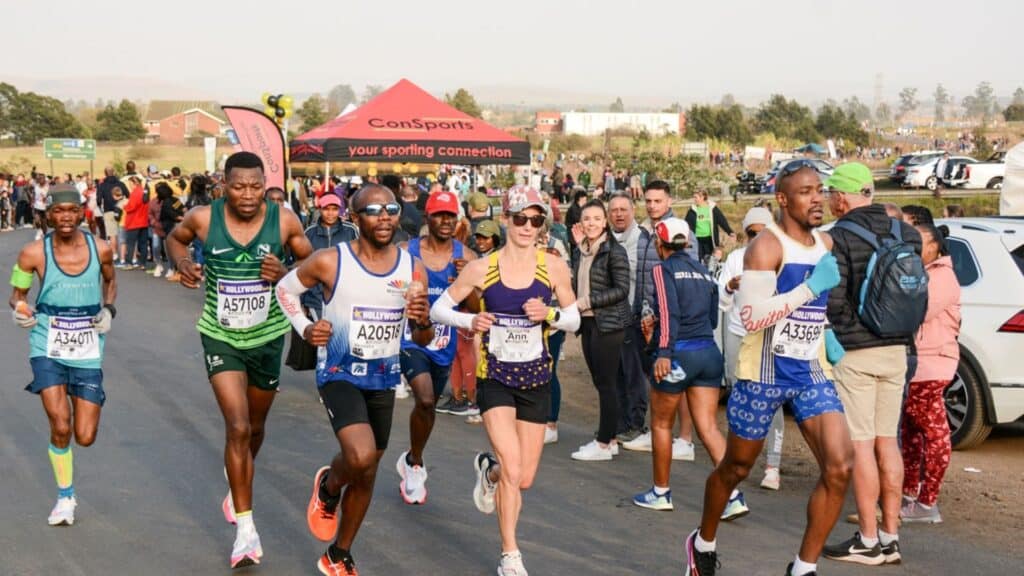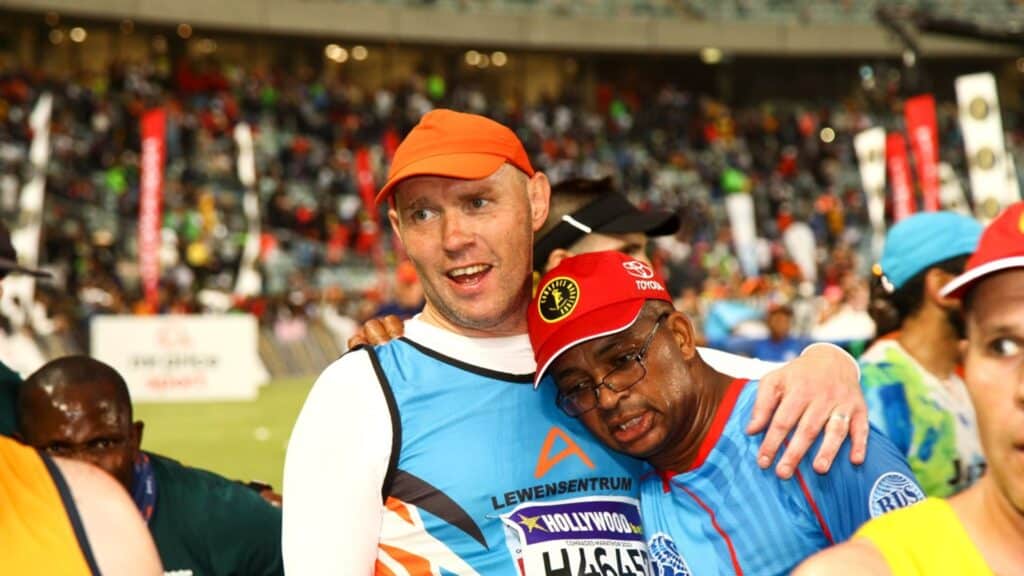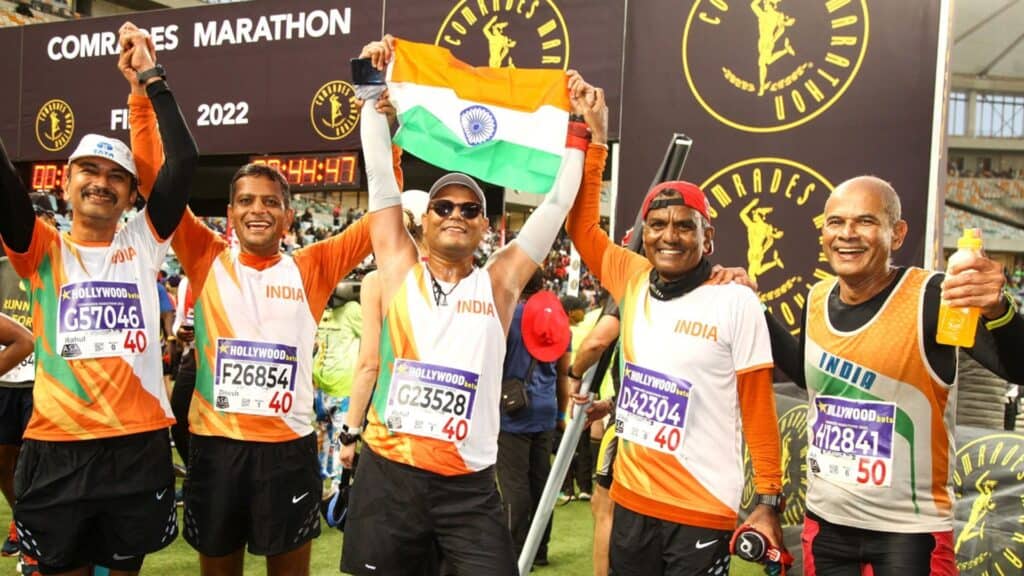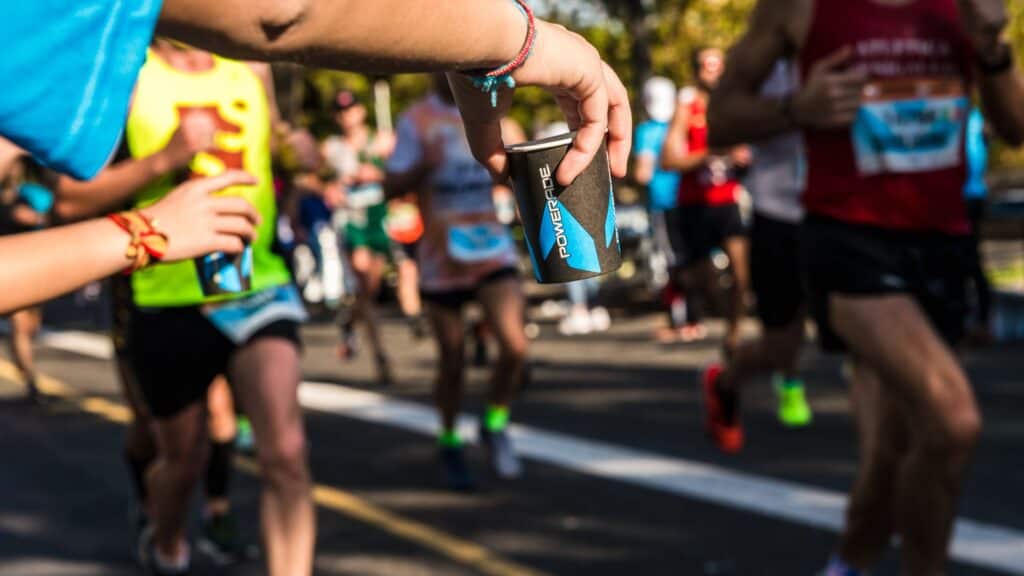Are you a runner who is inspired to participate in the Comrades Marathon?
The Comrades Marathon is an ultramarathon race in South Africa that covers a distance of 90 km (56 miles) between Durban and Pietermaritzburg. This race is not for the faint of heart, but with the right preparation, training, and mindset, you can conquer it.
This ultramarathon race is one of the most gruelling and challenging races worldwide. It tests one’s endurance, grit, and mental ability to push oneself to the finish line to claim the Ultimate Human Race title.
If you want to improve your performance in the race or are running it for the first time, we have got you covered. This blog post will provide you with essential tips for race day to ensure that you have an unforgettable Comrades Marathon experience.
So, let’s get started…

Choose The Right Program
To start your Comrades Marathon journey, the first thing you need is a training program. It’s crucial to choose the right one based on your running ability. If it’s not a good match, you might end up on race day either overtrained, undertrained, or, worse, dealing with an injury.
A common mistake is picking a program that’s too advanced, assuming it will prepare you well.
It’s important to match your training level with the right Comrades Marathon program. The key is to be well-prepared for the ultimate goal of finishing the Comrades Marathon.
So, how do you choose the right training plan for the Comrades?
- Determine Your Goals: Before choosing a training plan, you must determine your goals for the Comrades race. Are you aiming to beat your personal record or finish the race within a specific time? Depending on what you want to achieve, you can select the training plan that caters to your needs. Some training plans focus on speed, endurance, or both. Make sure to choose a plan that aligns with your goals.
- Evaluate Your Fitness Level: Your fitness level plays a vital role in selecting the right training plan. Assess your current fitness level and evaluate whether you are ready to take on an intense training plan. If you are a beginner, a novice training plan might be more suitable. Advanced runners may benefit from a high-intensity training plan to improve their performance. Make sure to choose the training plan that matches your fitness level.
- Research the Available Training Plans: Once you have determined your goals and evaluated your fitness level, the next step is to research the available training plans. Browse through various Comrades training plans available online, or consult with a coach. Review the training plan details, schedules, and structure to determine which plan works best for you. Be flexible in your search, and do not hesitate to tweak the schedule as per your needs.
- Consider Your Schedule and Lifestyle: Another significant factor to consider while choosing a training plan is your schedule and lifestyle. The plan should fit into your daily routine, work schedule, and family commitments. Would you prefer running in the morning or evening? How many days a week can you dedicate to training? These are some essential factors that you should consider while selecting a plan that matches your lifestyle.
Start Your Training Early
Getting ready for an ultramarathon, especially a challenging one like the Comrades Marathon, takes time and dedication. The key is to start your training early.
Aim to kick off your Comrades training at least six months before the big race. Why? Well, because it takes time to build up the endurance and strength you’ll need to conquer those long miles.
Starting early gives you the luxury of progressing gradually. You won’t be pushing your limits too hard, or too fast, which can lead to injuries.
Instead, you’ll be methodically building up your fitness level, allowing your body to adjust to the increasing demands of ultramarathon training.
Be Aware Of Your Mileage
If you’re on the Coach Parry finishers or Sub 12-hour Comrades training plan, your goal for the 6 months leading up to Comrades should be to cover a distance between 850km to 1000km, which is equivalent to 531 to 625 miles.
For those aiming for a Bronze medal, the target range is a bit higher, finishing Comrades training at approximately 950km to 1100km, translating to 594 to 688 miles.
Now, if you’re gunning for a Sub 10 Robert Mtshali medal, your ballpark range should be around 1200km to 1400km, which is about 750 to 875 miles. And for those eyeing a Bill Rowan, you’re looking at covering a distance of 1600km to 1800km, or 1000 to 1125 miles.
But if you’ve set your sights on the prestigious Comrades Silver or Gold medal, get ready for some serious mileage. You should be aiming for upwards of 2000 km, or 1250 miles, from the beginning of the year to race day. That’s the kind of dedication it takes to reach the top levels in the Comrades marathon.
How Many Miles Per Week Should You Run When Training For Comrades?
If you’re gearing up for the Comrades Marathon, the weekly mileage you should aim for depends on the medal you’re chasing. The Comrades Marathon is held on the second Sunday in June, providing approximately 22 weeks from January 1st until race day.
Breaking down the Comrades training mileage into weekly averages, here’s a guideline:
- Vic Clapham (Finishers/Sub 12-hour): Aim for an average of 39km to 45km (24 – 28 miles) per week.
- Bronze Medal: Shoot for an average of between 43km to 50km (27.7 – 31 miles) per week.
- Sub 10 Robert Mtshali Medal: Set your sights on an average of 55km to 64km (34.2 – 39.8 miles) per week.
- Bill Rowan: Go for an average of between 73km to 82km (45.7 – 51 miles) per week.
- Comrades Silver/Gold Medal: If you’re aiming for the top, you should be averaging over 145km (90.1 miles) per week.
Remember, these are weekly averages, and they are derived by taking the total mileage required for each medal and dividing it by the 22 weeks leading up to race day.
Adjusting based on how you feel and your body’s response is key, but these numbers provide a solid framework for your Comrades training.

At first glance, the weekly Comrades training mileage averages might seem a bit modest. However, it’s crucial to keep in mind that as you approach your peak training weeks in April, you’ll be ramping up the distance significantly compared to what you started with in January.
If your weekly mileage falls within the ranges mentioned earlier, rest assured, you’re on track to reach your goal. Resist the temptation that many Comrades runners face—adding more running days to boost mileage. Doing this increases the risk of injuries and might leave you fatigued or even injured on race day.
Instead of piling on more running days, consider adding one or two strength training sessions to your routine. Strengthening your muscles can be more
beneficial than pushing for extra running days, providing a more sustainable and injury-resistant approach to your Comrades training. It’s a smart way to enhance your overall performance without compromising your health come race day.
Cross Training & Strength Training For The Comrades Marathon
Cross-training and strength training often end up at the bottom of the to-do list, mainly because finding time for everything can be a challenge. However, when you’re logging in those long-distance runs, being strong is key, and giving your body breakthrough cross-training is crucial.
Cross-training is a game-changer. It lets you keep building your heart and lung strength without pounding your legs with constant impact. Many runners aim for 1-2 sessions of cross-training each week. Whether it’s swimming, cycling, or rowing, these low-impact activities can be a lifesaver.
Now, about strength training—it’s a must. Ideally, you’d want to slot in at least 2 pure strength sessions and then 1-2 pilates or yoga sessions are great to complement these.
Don’t Run Your Long Runs Too Fast
Running long runs the right way is all about taking it easy. And when we say “easy,” we mean really easy. Picture this: your pace should be so comfortable that you can have a nice chat with a running buddy without feeling like you’re gasping for air.
Why do we emphasize these leisurely long runs? Because they’re a big deal in getting you ready for the Comrades Marathon. They do a bunch of important things for you, with the main one being boosting your endurance and aerobic capacity.
When you do these long runs, your muscles get better at using the fuel they need for those longer distances. It’s like training them to become super-efficient powerhouses.
Plus, your body learns to handle being active for longer periods without feeling like it’s about to call it quits.
During long runs, you have the perfect opportunity to experiment with various nutrition strategies that can help you find the perfect fuel for your stomach.
Stay Hydrated and Fueled
Making sure you have enough to drink and eat is very important for any athlete, especially if you’re gearing up for an ultramarathon like the Comrades.
Hydration:
It is crucial to maintain proper hydration during your training runs as well as on the day of the race. To ensure that you stay refreshed, it is recommended that you sip on water and electrolyte drinks throughout your training sessions.
Additionally, it is important to stick to your hydration strategy ahead of time and stop at the designated water stations during the race as per your plan. This will help you replenish the fluids and electrolytes lost during the run, prevent dehydration, and enable you to perform at your best.
Remember, staying hydrated is key to a successful and enjoyable running experience.

Nutrition:
To ensure that your body has enough energy to keep up, it’s important to feed it the right mix of carbohydrates and proteins. Planning your meals and snacks with this in mind can help keep your energy levels up throughout the day.
Think of it as giving your body the fuel it needs to keep going strong. By providing your body with the nutrients it needs, you can help ensure that you are always performing at your best.
Whether you’re clocking miles or hitting the racecourse, taking care of what you drink and eat is key.
Be Mentally Prepared
Before the big day, consider taking a drive along the Comrades Marathon route. It might seem a bit intimidating, but it’s a smart move to understand the distance you’ll be covering. Just be sure to do it at least 2 days before race day, you do not want to spend hours cramped up in a car the day before the race.
Feeling a bit nervous is totally okay; in fact, it can make you more cautious on race day and therefore a more successful Comrades runner compared to someone who is overly confident or arrogant.
This simple drive can help you visualize the journey ahead and wrap your head around the sheer distance. Embracing a bit of nervousness shows respect for the challenge, paving the way for a more grounded and determined approach on race day.
Prioritize Rest and Recovery
Giving your body time to rest and recover is a crucial aspect of any training plan, especially when gearing up for an ultramarathon like the Comrades.
Rest is very important. It’s during the recovery phase after exercise that your body builds up its fitness.
So, make sure to factor in some downtime. This can take the form of active recovery, like a casual walk or a different kind of workout. Most runners benefit from having a full rest day once a week. This not only reduces the risk of injuries but also prevents excessive fatigue, both physical and mental.
Listen to your body. If you find yourself needing more sleep than usual, go for it. Your body is telling you what it needs, and extra sleep can do wonders.
Also, pay attention to what you eat. A balanced diet with enough carbohydrates for energy and protein for recovery is crucial.
Remember, your body is doing some serious work during training, and the rest and recovery period is when the magic happens.

Remember To Have Fun
In all the talk about the big 90 km (56 miles) challenge, the tough climbs, and the seriousness of the Comrades Marathon, it’s important not to forget the joy in the journey.
Enjoy the run! Yes, it’s a big task, and yes, you’ve heard about it a lot, and it’s okay to feel a bit scared. But, amid the challenge, don’t forget to have some fun.
The first 40 km (24.9 miles) are a great chance to connect with the crowd, chat with other runners, and get more out of the Comrades experience than just a race. When things get tough later on, the memories of the early fun will be your secret weapon.
Having a good time throughout the day means you won’t be using up too much energy on stress. Talking with people, enjoying the view, and just embracing the whole experience will make the kilometers go by without feeling like a never-ending task.
Arrive Early On Race Day
Make sure to get there early! Your family can’t come up to the start, so it’s best to have them drop you off. The pens close 15 minutes before the race kicks off, so be sure to give yourself plenty of time to get to your assigned group.
If not, you might end up starting at the back, and it could take up to 6 minutes to cross the start line.
Now that you’ve got the lowdown on what to expect while training for an ultra marathon, who’s ready to sign up and take on the Comrades Marathon in 2026?!
Related: Comrades Marathon Entries: EVERYTHING You Need To Know
About The Comrades Marathon Course
The Comrades Route is a point-to-point run between the cities of Pietermaritzburg and Durban. It alternates each year between an “up” run (starting in Durban and ending in Pietermaritzburg) and a “down” run (starting in Pietermaritzburg and ending in Durban).
The race is an arduous climb, with multiple steep hills throughout. The race’s highest point occurs at the 87-km (54.1 miles) mark, and it is called the Polly Shortts Hill.
Comrades, as many South Africans know, takes place in a part of KwaZulu-Natal known as the Valley of a Thousand Hills. The terrain is rugged, not for the easily discouraged, especially when tackling the demanding down run.
The Down Run Start Line
The starting point for the Comrades Marathon Down Run is just outside the Pietermaritzburg Hall.
Keep in mind that it can be quite chilly in the morning, with an average minimum temperature of around 4°C or 39°F. I recommend wearing an extra layer of clothing.
Additionally, make sure to arrive early at the start line. Drop off your belongings at the tog bag area and then head to your seeding pens.

The route profile indicates a significant amount of climbing in the first half, including the ascent to the highest point at Umlaas Road. The effort continues until the climb out of Drummond towards Botha’s Hill.
The downhill stretch from the top of Botha’s Hill to the bottom of Fields Hill is a distinctive feature of the Down run, posing challenges for many runners. Some speed down this descent to save time, only to encounter difficulties in the final quarter of the race.
Saving energy before the climb over Cowies Hill allows for time recovery through Westville as you approach the finish in Durban.
For a detailed and comprehensive description of the Comrades Marathon Down Run, covering the route profile, map, and additional information, check out this post: “The Comrades Marathon Down Run Profile, Map & Description.”
The Up Run Start Line
In contrast to the Down Run, the Up Run of the Comrades Marathon is one of the hardest marathons you will ever run because it is a very challenging course, especially in the first half.
You can easily get to the starting line (outside the old Workshop in Durban) by using e-hailing services such as Uber and Bolt. Some runners even prefer to walk to the start line.
While walking in those early morning hours, it’s advisable not to walk alone. Instead, join other Comrades runners for safety.
The atmosphere at the Durban start is vibrant and festive, with well-lit streets and a rock concert-like ambience.
Arriving early at the start line. This allows time for using facilities, securing your tog bag on the truck, and positioning yourself in your starting pen to maintain your seeding.

The start of the Comrades Up Run in Durban differs from Pietermaritzburg, with wider roads allowing for a quicker crossing of the line. Additionally, Durban is several degrees warmer.
Related: The Up Run Profile, Map & Description
The Comrades Marathon is a life-changing experience, and following our tips will ensure you have a fantastic time during your race day. Like any other marathon, it requires thorough preparation and dedication that spans months or even years.
Remember that while it is an individual journey, the support of a pre and post-race team could make a significant difference in the performance and enjoy the experience to the utmost.
Be sure to keep these tips in mind as you prepare for your first Comrades Marathon. Happy Running!



Comments are closed.